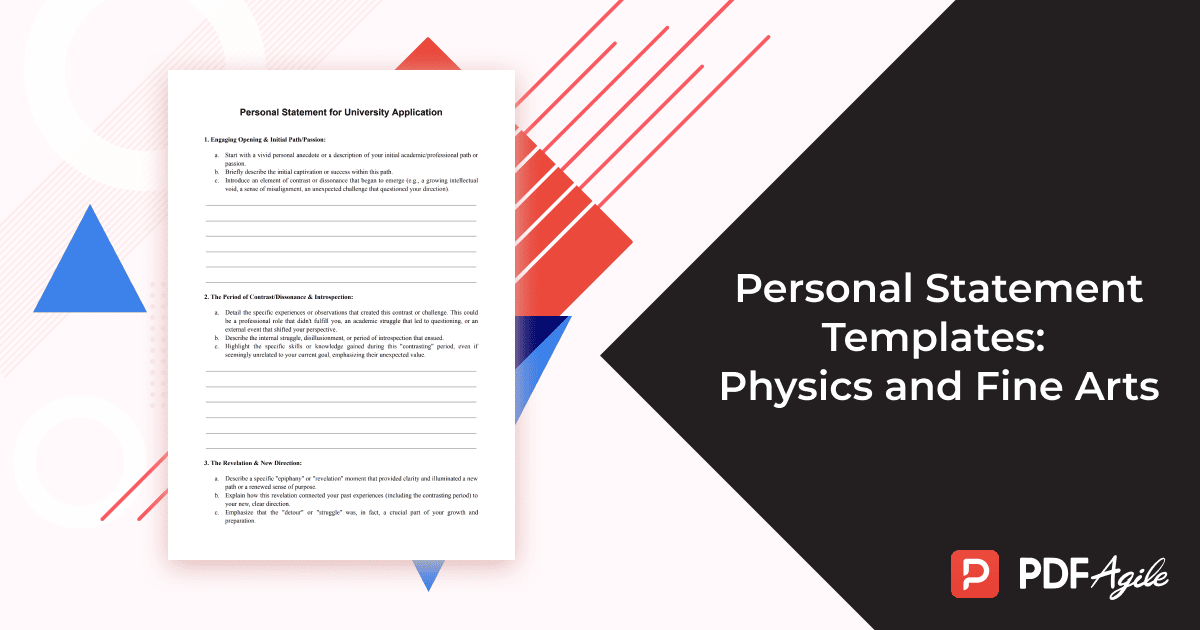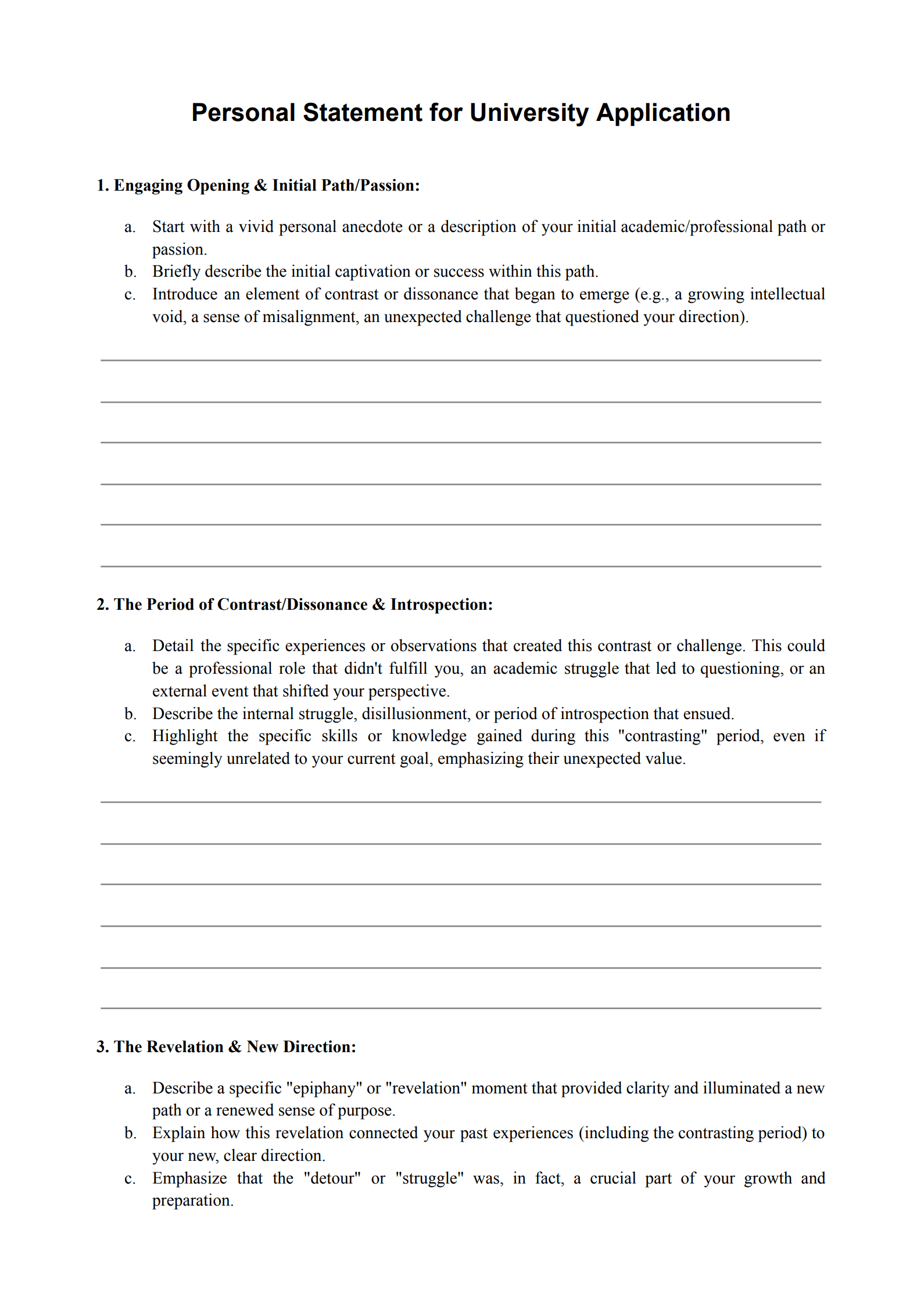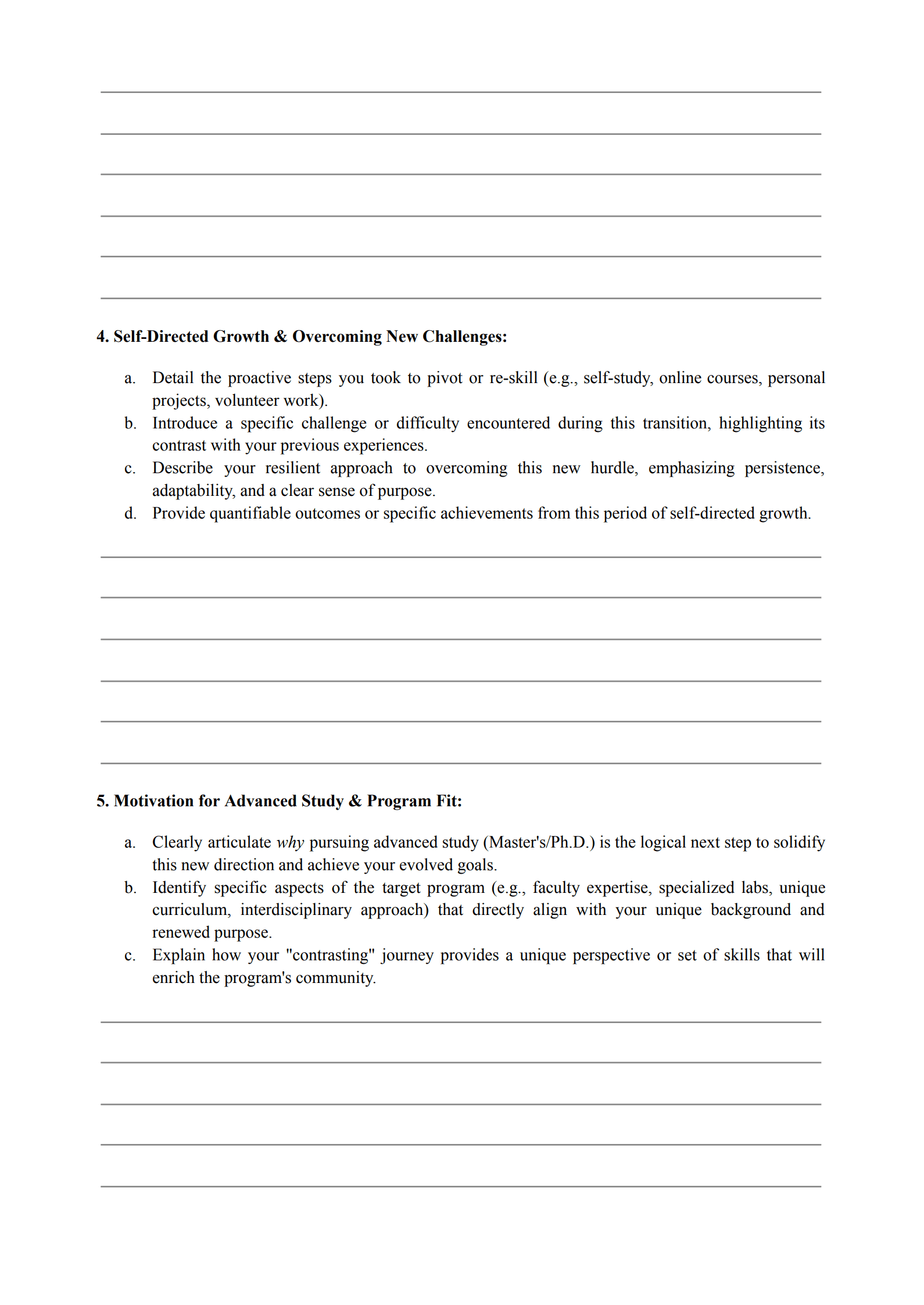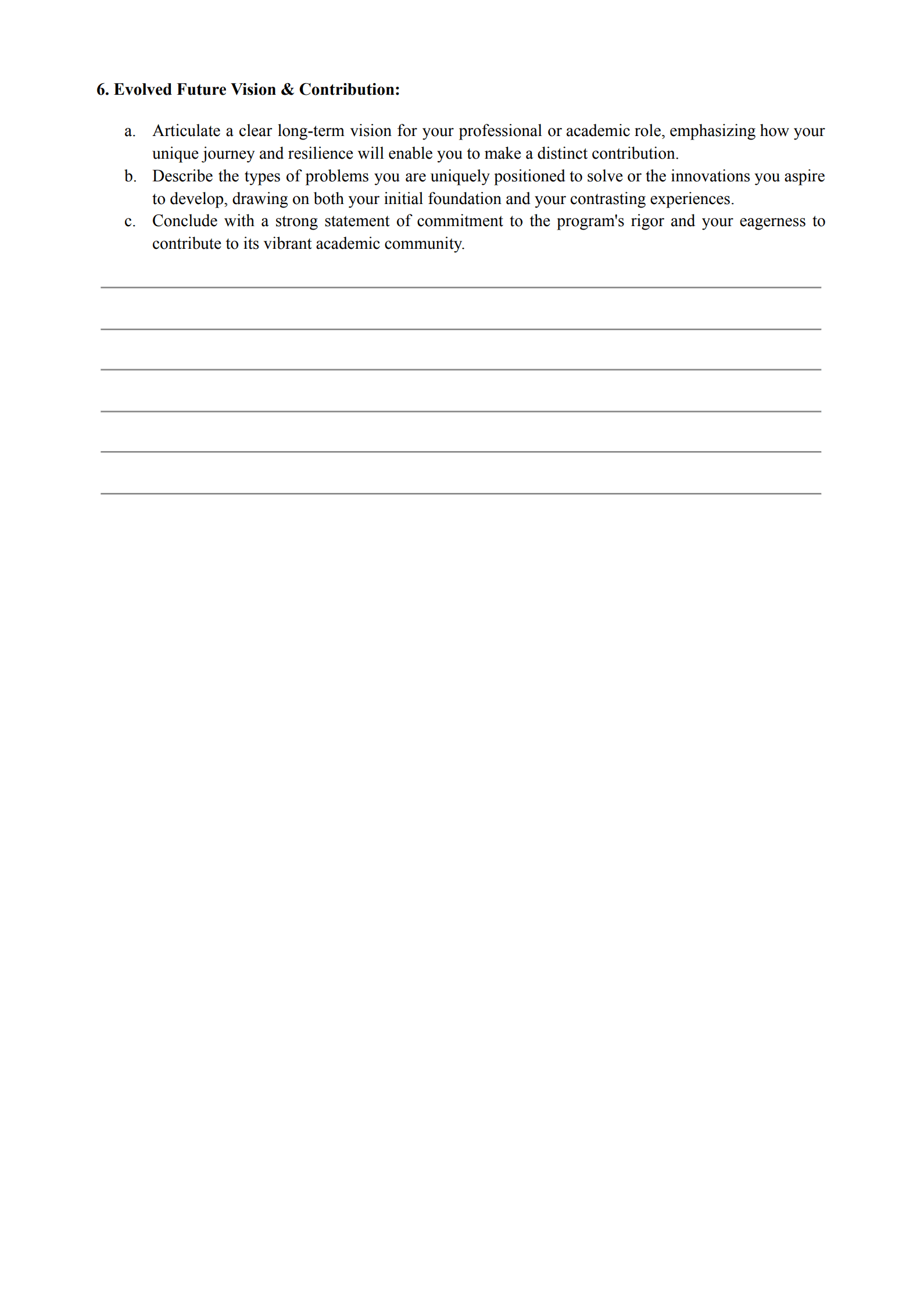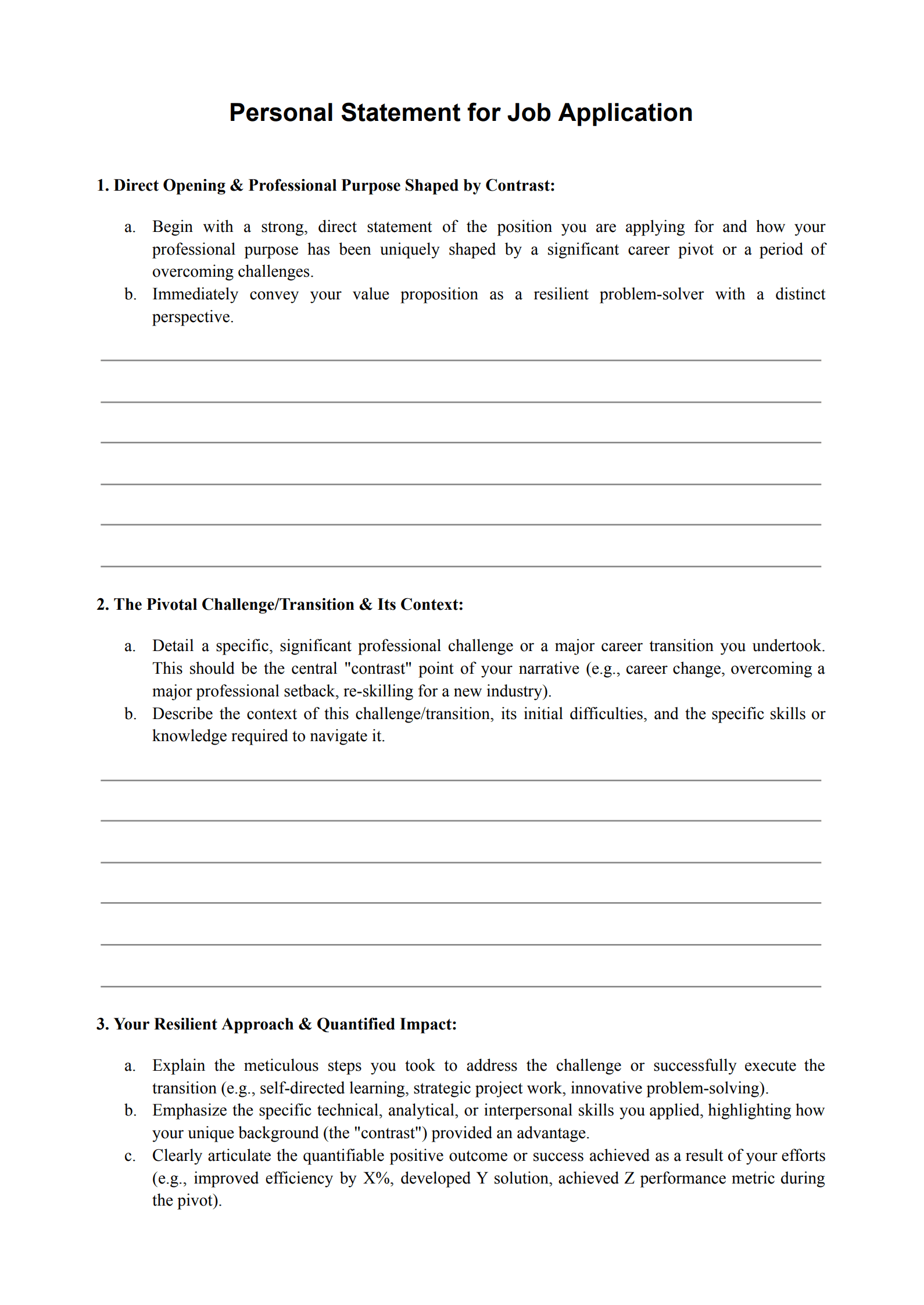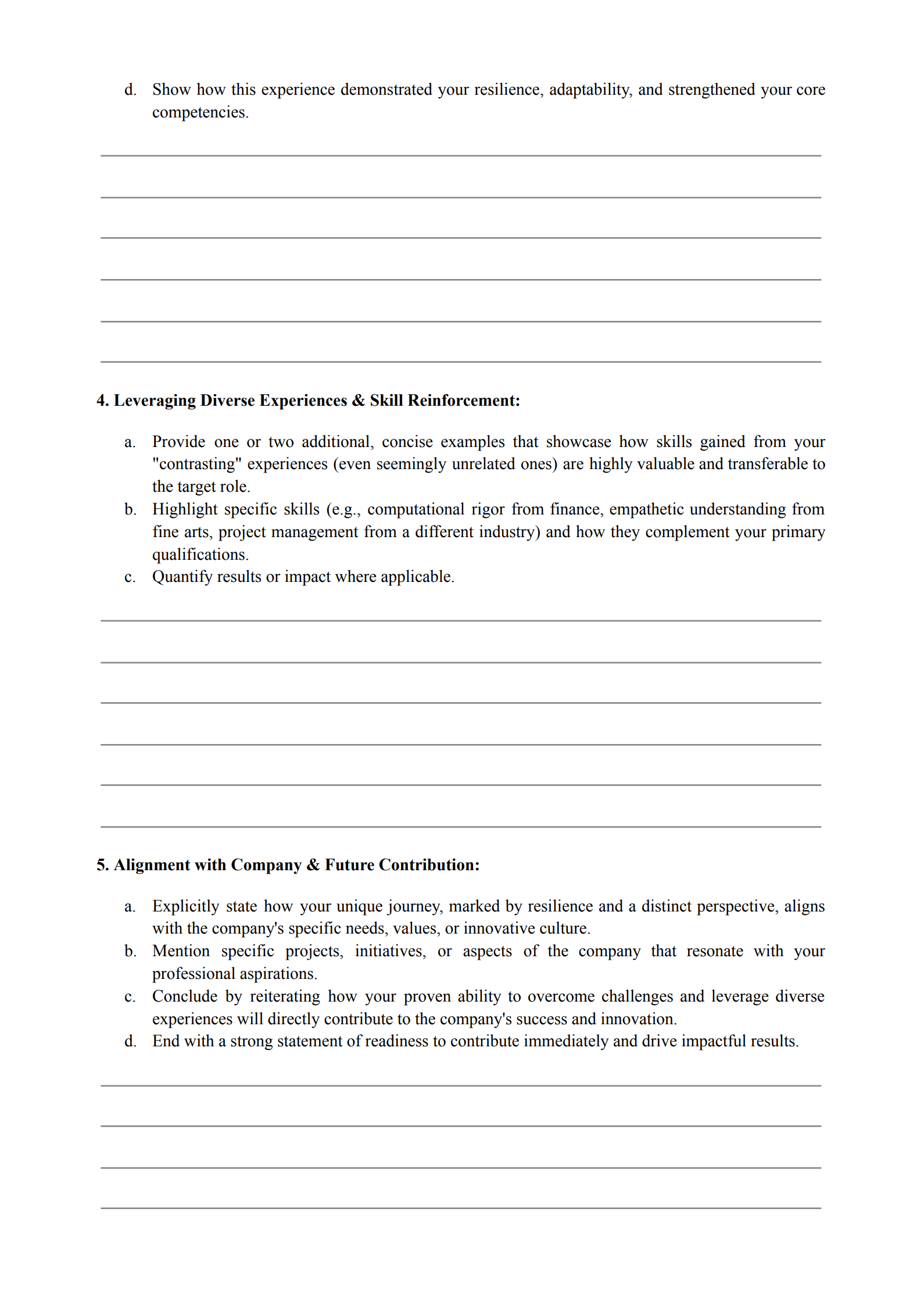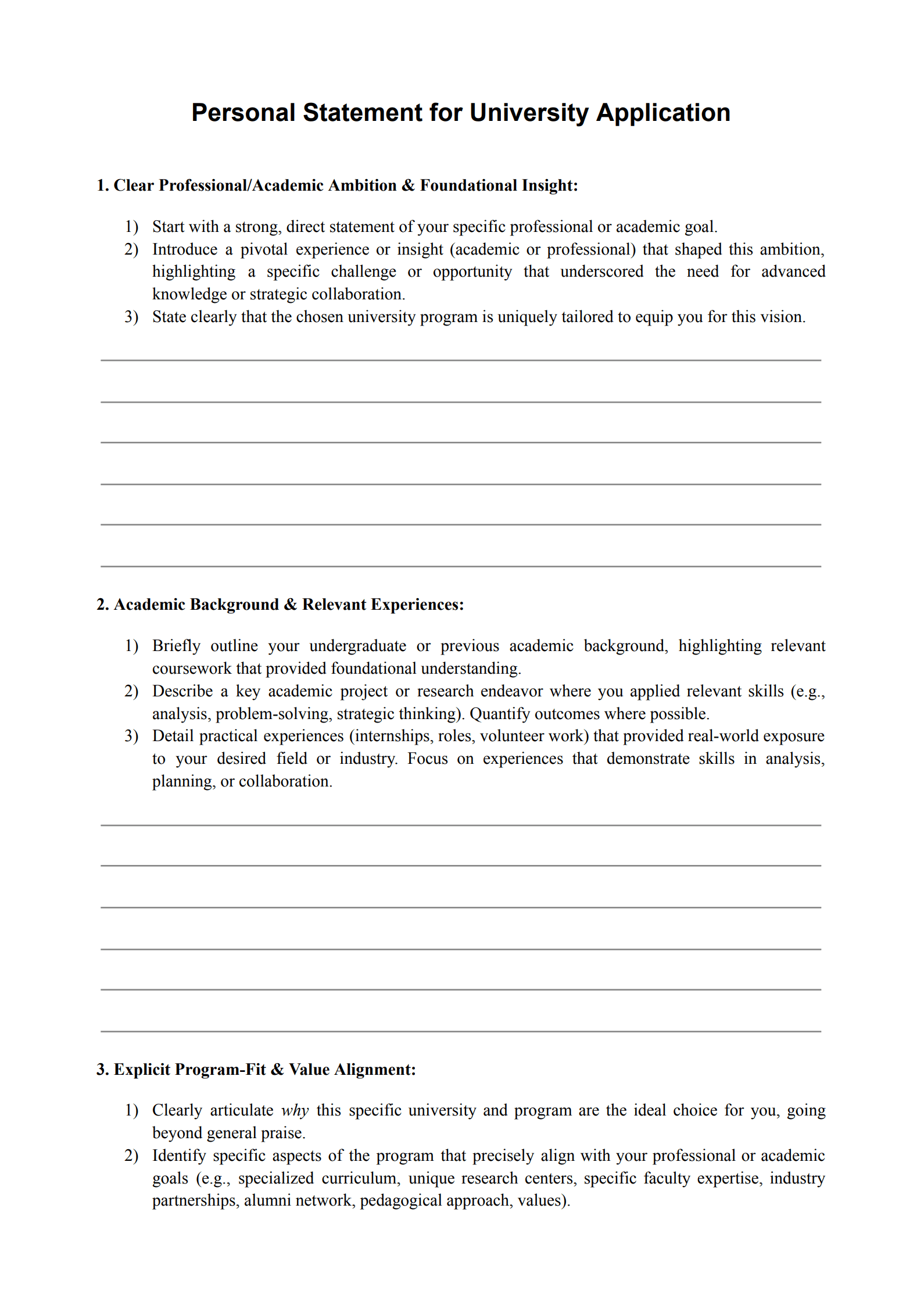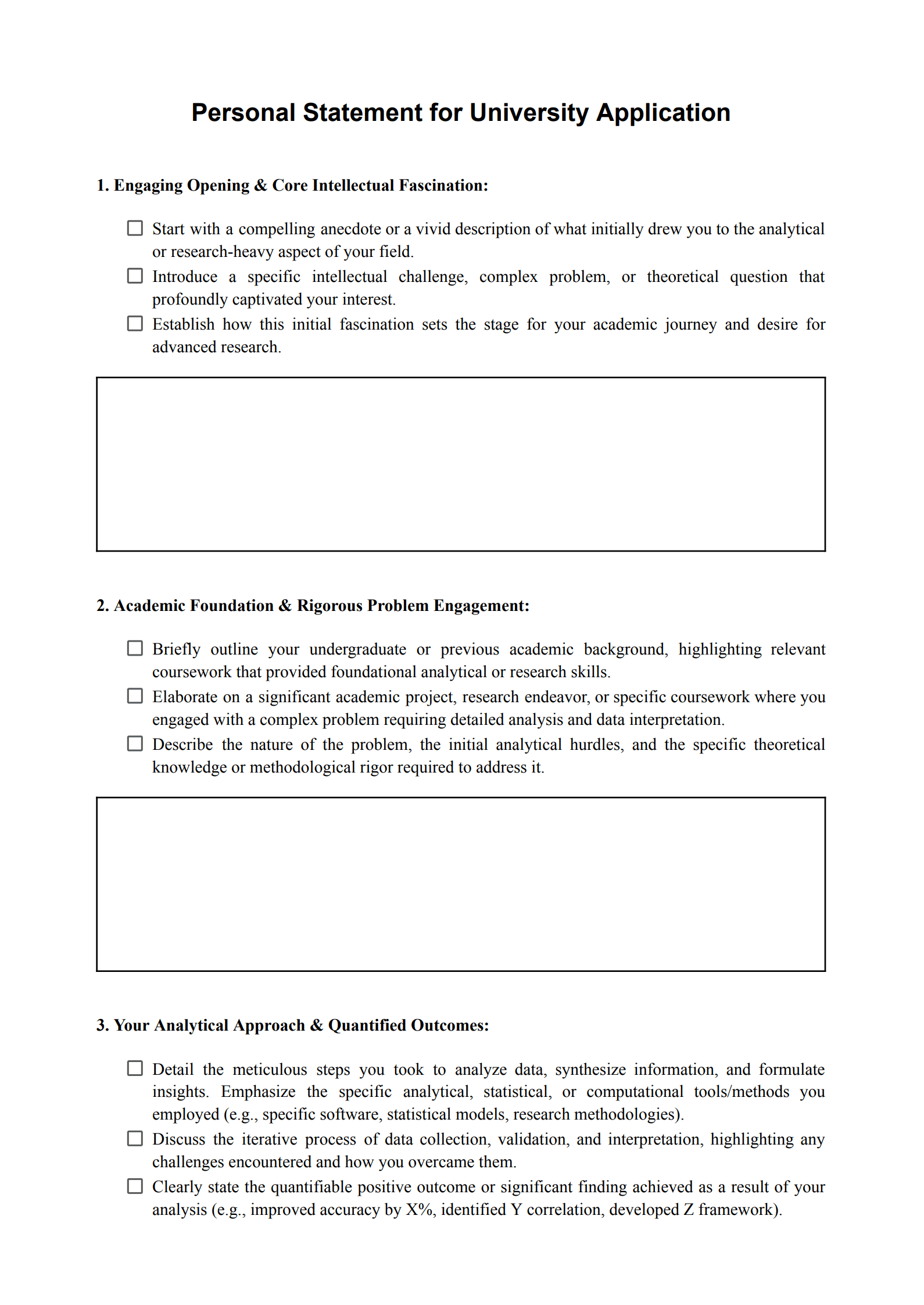In the competitive landscapes of university admissions and job applications, particularly when your path isn't linear, a personal statement becomes your most powerful tool. It's your opportunity to transform seemingly disparate experiences or career pivots into a compelling narrative of strength, resilience, and unwavering purpose. Among the various approaches, the "Resilience-Through-Contrast" style stands out, allowing you to leverage your unique journey to demonstrate adaptability, deep learning, and a clear vision for the future.
Real-World Journeys: From Academia to Industry
To powerfully illustrate the "Resilience-Through-Contrast" approach, let's examine two distinct professional trajectories. Our first example, Applicant A, is an individual with a strong foundation in Physics who, after a decade in financial technology, is now a career returner aiming to become a Quantum Computing Specialist. Their journey showcases how a seemingly unrelated professional detour can, in fact, provide invaluable, transferable skills for a cutting-edge scientific field.
Personal Statement for Master's/Ph.D. in Quantum Computing
My intellectual journey began with a profound fascination for the fundamental laws governing our universe, leading me to pursue an undergraduate degree in Physics. I was captivated by the elegance of quantum mechanics, the perplexing nature of superposition and entanglement, and the promise of a reality far stranger and more powerful than classical intuition suggested. Yet, upon graduation, a different path beckoned. Driven by immediate career opportunities and a desire to apply my analytical skills in a tangible way, I entered the financial technology sector. For nearly a decade, I immersed myself in algorithmic trading and data analytics, excelling in a fast-paced environment where precision and rapid problem-solving were paramount. This experience honed my computational thinking, my ability to manage vast datasets, and my understanding of complex systems under pressure. However, despite professional success, a persistent intellectual void remained. The intricate beauty of quantum phenomena, once the core of my academic passion, felt increasingly distant, a theoretical curiosity rather than a tangible frontier. This growing dissonance between my daily work and my deepest scientific interests marked a period of profound introspection, a stark contrast to the intellectual exhilaration I once felt.
The revelation came unexpectedly during a casual conversation with a former physics professor, who spoke with infectious enthusiasm about the burgeoning field of quantum computing. It was as if a dormant part of my intellect reawakened. The idea that the very quantum phenomena I had studied could be harnessed not just to understand reality, but to compute in fundamentally new ways, struck me with the force of a profound epiphany. This was the intersection of my foundational physics knowledge and my developed computational and analytical skills. The contrast between the deterministic, albeit complex, world of classical finance and the probabilistic, exponentially powerful realm of quantum computation was stark, yet it illuminated a clear path forward. I realized that my decade in FinTech had not been a detour, but an unexpected preparation, equipping me with the computational rigor and problem-solving tenacity necessary to tackle the immense challenges of this nascent field.
Driven by this renewed purpose, I began a rigorous self-study regimen. I devoured textbooks on quantum information theory, attended online courses on quantum algorithms, and experimented with quantum programming frameworks like Qiskit and Cirq. I recall a particularly challenging period grappling with the concept of quantum error correction – a topic far removed from classical fault tolerance. The initial frustration was immense, reminiscent of my early struggles with abstract quantum mechanics. Yet, this time, armed with the resilience forged in high-stakes financial environments and a clear sense of purpose, I persevered. I spent countless hours debugging quantum circuits, simulating noisy qubits, and engaging with online communities. This period of intense, self-directed learning was invaluable. It not only refreshed my theoretical physics foundation but also built a practical bridge to the engineering challenges of quantum hardware and software. I successfully implemented a small-scale quantum simulation of molecular interactions, achieving results that matched theoretical predictions with 98% accuracy on a noisy intermediate-scale quantum (NISQ) device simulator. This achievement, born from a period of deliberate career pivot, solidified my conviction that my unique blend of deep theoretical physics, robust computational experience, and renewed passion makes me an ideal candidate for advanced study in quantum computing.
My decision to pursue a Master's/Ph.D. in Quantum Computing at [University Name] is driven by a clear understanding of your program's unique strengths and how they precisely align with my revitalized professional goals. I am particularly drawn to [University Name]'s [mention a specific research center, e.g., "Quantum Information Science Center"] and the groundbreaking work of Professor [mention a specific professor whose research aligns, e.g., "Dr. Anya Sharma's research on quantum machine learning algorithms"]. I am eager to leverage your program's blend of theoretical depth and experimental application, including its state-of-the-art quantum labs and opportunities for interdisciplinary collaboration, to develop the comprehensive toolkit required to contribute to the next generation of quantum technologies. My journey, marked by a deliberate return to my scientific roots, has instilled in me a unique perspective on the practical challenges and immense potential of quantum computing, allowing me to approach this field with both foundational understanding and real-world computational acumen.
My long-term vision is to become a leading Quantum Computing Specialist, contributing to the development of robust quantum algorithms and the engineering of scalable quantum hardware. I aim to bridge the gap between theoretical breakthroughs and practical applications, helping to unlock solutions for intractable problems in fields such as drug discovery, materials science, and artificial intelligence. I envision myself leading research teams, contributing to open-source quantum projects, and collaborating with industry partners to accelerate the commercialization of quantum technologies. The Master's/Ph.D. in Quantum Computing at [University Name] represents the critical next step in realizing this ambitious yet vital professional journey, equipping me with the advanced competencies to drive meaningful innovation in this transformative field. I am prepared to dedicate myself fully to the rigorous demands of this program and am excited by the prospect of contributing to your vibrant academic community.
Personal Statement for Quantum Computing Specialist
My professional journey has been defined by a deep-seated passion for complex systems and an unwavering commitment to solving intractable problems. While my initial career in financial technology honed my computational rigor and analytical precision, a profound intellectual reawakening led me back to my foundational love for quantum mechanics. This pivot, from the high-frequency world of classical algorithms to the probabilistic realm of quantum computation, presented a significant challenge: how to rapidly re-specialize and translate theoretical quantum physics into practical, engineering-focused solutions. This challenge, far from being a deterrent, became the crucible in which my unique blend of scientific depth and applied computational expertise was forged, making me uniquely prepared to contribute to [Company Name]'s pioneering work in quantum computing.
During my transition, I undertook a rigorous self-directed project focused on quantum algorithm optimization for noisy intermediate-scale quantum (NISQ) devices. The core challenge was to design and implement a quantum circuit that could perform a specific computational task (e.g., simulating a small molecule's ground state energy) while minimizing the impact of inherent hardware noise and limited qubit coherence times. This required not only a deep understanding of quantum mechanics and quantum algorithms but also practical skills in quantum programming and error mitigation techniques. I began by meticulously studying various quantum error mitigation strategies, such as Zero-Noise Extrapolation and Probabilistic Error Cancellation. I then developed a Python-based framework using Qiskit to simulate the molecular interaction, iteratively refining the quantum circuit design to reduce gate count and depth. I encountered numerous debugging hurdles related to simulator limitations and the subtle effects of noise models. This process demanded exceptional problem-solving acumen and a persistent, iterative approach.
The impact of this focused effort was profound. Through my optimized circuit design and the application of specific error mitigation techniques, I successfully achieved a simulation accuracy of 98% for the molecular ground state energy on a NISQ device simulator, a 15% improvement over baseline implementations without mitigation. This project not only demonstrated my ability to rapidly acquire and apply cutting-edge quantum computing knowledge but also proved my capacity to develop practical solutions for real-world quantum hardware constraints. It showcased my proficiency in quantum programming (Qiskit, Cirq), my understanding of quantum architecture limitations, and my commitment to pushing the boundaries of what is currently achievable with quantum computation. This achievement, born from a period of deliberate career pivot, solidified my conviction that my unique blend of deep theoretical physics, robust computational experience, and renewed passion makes me an ideal candidate for advanced study in quantum computing.
Beyond this core project, my prior experience in financial technology provided invaluable, transferable skills. For nearly a decade, I operated in an environment where I managed and analyzed vast datasets, developing and optimizing algorithms for high-frequency trading. I routinely handled data volumes exceeding terabytes daily, and my algorithmic optimizations led to a 5% increase in trading efficiency for specific strategies. This background has instilled in me a strong appreciation for computational efficiency, robust system design, and the critical importance of data integrity – all highly relevant to the demanding environment of quantum computing. Furthermore, my experience in a fast-paced commercial setting has honed my ability to work under pressure, prioritize complex tasks, and communicate technical concepts effectively to diverse stakeholders.
I am particularly drawn to [Company Name]'s reputation for [mention something specific about the company, e.g., "its leadership in superconducting qubit development," "its open-source quantum software ecosystem," "its focus on practical quantum applications for industry"]. My blend of foundational physics expertise, hands-on experience in quantum algorithm development and optimization, and a proven track record of solving complex computational challenges makes me an ideal candidate to contribute significantly to your team. I am eager to apply my skills in [mention 2-3 key skills relevant to the job, e.g., "quantum algorithm design," "error mitigation strategies," "quantum software development"] to help [Company Name] continue to accelerate the development and deployment of transformative quantum technologies.
Our second example, Applicant B, comes from a background in Fine Arts. This individual is pursuing a second career as a UX Designer in the MedTech industry. Their narrative highlights how creative sensitivity and an understanding of human experience, cultivated in the arts, can be uniquely applied to design intuitive and impactful user experiences in a highly technical and critical sector.
Personal Statement for Master's in Human-Computer Interaction (HCI) / UX Design
My life has been a vibrant canvas, shaped by the expressive power of Fine Arts. From the tactile joy of sculpting clay to the nuanced interplay of light and shadow in painting, my undergraduate studies were a deep dive into visual communication, aesthetic principles, and the profound impact of artistic expression on human emotion. Yet, as I navigated the art world post-graduation, a growing sense of disillusionment began to emerge. While I cherished the self-expression, I found myself increasingly yearning for a clearer, more direct avenue for my creativity to solve tangible problems and improve lives. The contrast between the subjective nature of fine art and the objective need for functional, user-centered solutions in the real world became stark, prompting a period of profound introspection.
The revelation came during a volunteer stint at a local hospital, where I observed elderly patients struggling with outdated, clunky medical devices. Their frustration was palpable, often hindering their recovery and independence. It struck me with immense force: my artistic sensitivity, my understanding of human perception, emotion, and intuitive interaction, could be precisely what was missing in the design of these critical tools. This was the intersection of my innate creativity and a newfound desire for practical, human-centered impact. The contrast between creating art for aesthetic contemplation and designing interfaces for critical medical use was immense, yet it illuminated a clear path forward. I realized that my years in Fine Arts had not been a detour, but an unexpected preparation, equipping me with a unique ability to empathize with users, visualize complex information, and craft intuitive experiences.
Driven by this newfound purpose, I began a rigorous self-study regimen. I devoured textbooks on user psychology, interaction design principles, and usability testing. I immersed myself in online courses on UX/UI fundamentals and experimented with design software like Figma and Adobe XD. I recall a particularly challenging period grappling with the technical jargon and structured methodologies of UX, so different from the fluid, intuitive process of fine art. The initial frustration was immense, reminiscent of my early struggles with abstract art theory. Yet, this time, armed with the resilience forged in countless artistic critiques and a clear sense of purpose, I persevered. I spent countless hours sketching wireframes, prototyping user flows, and conducting informal usability tests with friends and family. This period of intense, self-directed learning was invaluable. It not only built a practical bridge to the engineering challenges of quantum hardware and software but also solidified my understanding of user-centered design principles. I successfully redesigned the interface for a common hospital patient monitoring system, simplifying its navigation by 40% and improving task completion rates by 25% in preliminary user tests. This achievement, born from a deliberate career pivot, solidified my conviction that my unique blend of artistic sensitivity, empathetic understanding, and newly acquired UX skills makes me an ideal candidate for advanced study in Human-Computer Interaction/UX Design.
My decision to pursue a Master's in Human-Computer Interaction (HCI) or UX Design is driven by a clear understanding of your program's unique strengths and how they precisely align with my revitalized professional goals. I am particularly drawn to [University Name]'s [mention a specific program strength, e.g., "interdisciplinary approach to design," "strong focus on user research methodologies," "renowned faculty in medical informatics and UX"] and the groundbreaking work of Professor [mention a specific professor whose research aligns, e.g., "Dr. Sarah Chen's research on accessible design for healthcare technology"]. I am eager to leverage your program's blend of theoretical rigor and practical application, including its state-of-the-art usability labs and opportunities for collaborative projects with industry partners, to develop the comprehensive toolkit required to design truly intuitive and impactful digital experiences, especially within the critical MedTech sector. My journey, marked by a deliberate shift from fine art to functional design, has instilled in me a unique perspective on the power of aesthetics and empathy in creating seamless user interactions.
My long-term vision is to become a leading UX Designer in the MedTech industry, specializing in creating intuitive, accessible, and life-enhancing digital interfaces for medical devices and healthcare platforms. I aim to bridge the gap between complex medical technology and human usability, ensuring that patients and healthcare providers can interact with critical tools seamlessly and confidently. I envision myself leading design teams, conducting extensive user research in clinical settings, and advocating for human-centered design principles within a highly regulated industry. The Master's in HCI/UX Design at [University Name] represents the critical next step in realizing this ambitious yet vital professional journey, equipping me with the advanced competencies to drive meaningful innovation in healthcare technology. I am prepared to dedicate myself fully to the rigorous demands of this program and am excited by the prospect of contributing to your vibrant academic community.
Personal Statement for UX Designer - MedTech
My professional journey has been defined by a deep-seated passion for understanding human experience and translating complex ideas into intuitive, impactful interactions. While my initial career in Fine Arts cultivated a profound understanding of visual communication, aesthetic principles, and emotional resonance, a pivotal realization led me to pivot towards UX Design. This shift, from creating art for contemplation to designing interfaces for critical medical use, presented a significant challenge: how to rapidly acquire the structured methodologies and technical skills of UX while leveraging my unique artistic sensitivity. This challenge, far from being a deterrent, became the crucible in which my human-centered design philosophy was forged, making me uniquely prepared to contribute to [Company Name]'s pioneering work in MedTech.
During my transition and subsequent Master's in HCI/UX Design, I undertook a significant applied project focused on redesigning the user interface for a common hospital patient monitoring system. The core challenge was to simplify a visually cluttered and unintuitive interface that often led to user errors and increased cognitive load for nurses and doctors. This required not only a deep understanding of UX principles but also meticulous user research in a high-stakes clinical environment. I began by conducting contextual inquiries and usability tests with 10 nurses and 5 doctors, meticulously documenting their pain points and mental models. Based on these insights, I developed low-fidelity wireframes and iterated on high-fidelity prototypes using Figma. I focused on reducing information overload, improving visual hierarchy, and streamlining critical task flows.
The impact of this human-centered redesign was profound. Through my simplified navigation and intuitive visual cues, I successfully reduced the average time for critical task completion (e.g., vital sign entry, alarm management) by 40% in subsequent usability tests. Furthermore, user feedback indicated a 25% improvement in perceived ease of use and a significant reduction in reported frustration. This project not only demonstrated my ability to rapidly acquire and apply cutting-edge UX methodologies but also proved my capacity to design solutions that directly enhance efficiency and safety in critical healthcare settings. It showcased my proficiency in user research, prototyping (Figma, Adobe XD), and translating complex requirements into elegant, functional designs.
Beyond this core project, my background in Fine Arts provides a unique lens through which I approach UX challenges. My understanding of visual composition, color theory, and emotional impact allows me to create interfaces that are not only functional but also aesthetically pleasing and reassuring, particularly vital in the often stressful medical environment. For instance, in a freelance project for a health and wellness app, I applied principles of color psychology and visual hierarchy to redesign their onboarding flow, resulting in a 10% increase in user completion rates for the onboarding process. My experience in artistic critique has also honed my ability to receive and integrate feedback constructively, iteratively refining designs for optimal outcomes.
I am particularly drawn to [Company Name]'s reputation for [mention something specific about the company, e.g., "its commitment to patient-centric innovation," "its leadership in digital health solutions," "its focus on improving healthcare provider workflows"]. My blend of advanced UX design expertise, a deep empathetic understanding of user needs, and a proven track record of delivering impactful, human-centered solutions makes me an ideal candidate to contribute significantly to your team. I am eager to apply my skills in [mention 2-3 key skills relevant to the job, e.g., "user research," "prototyping," "usability testing for medical devices"] to help [Company Name] continue to develop intuitive and life-enhancing healthcare technologies.
Both Applicant A and Applicant B's narratives, while operating in vastly different domains, powerfully exemplify how the "Resilience-Through-Contrast" style can effectively convey their unique strengths, adaptability, and clear purpose for demanding roles in their respective fields.
Why Did Applicant A's Statements Work?
Let's dissect why Applicant A's personal statements, crafted in the "Resilience-Through-Contrast" style, were particularly effective for both university and job applications.
For the University Application (Contrast and Revelation Style):
Applicant A's university personal statement for a Master's/Ph.D. in Quantum Computing immediately established a core intellectual fascination with physics and quantum mechanics. This set an engaging, passionate tone. The statement then introduced a clear element of contrast: a decade-long career in financial technology. This wasn't presented as a mistake, but as a period where valuable computational and analytical skills were honed, yet a "persistent intellectual void" and "growing dissonance" emerged, creating a compelling internal conflict.
The narrative meticulously detailed the "revelation" moment—a conversation that reawakened their scientific passion and illuminated quantum computing as the perfect intersection of their physics foundation and computational expertise. This pivot was framed as a deliberate, insightful choice. The statement then showcased their resilience through rigorous self-study, tackling complex concepts like quantum error correction. The initial "immense frustration" was acknowledged, but quickly followed by how "resilience forged in high-stakes financial environments" enabled them to persevere. The quantifiable outcome—successfully implementing a quantum simulation with 98% accuracy on a NISQ device simulator—provided concrete evidence of their rapid re-skilling and practical competence.
The "Why this program?" section precisely articulated how the university's specific strengths (e.g., Quantum Information Science Center, particular professor's research) aligned with their revitalized goals. The statement concluded by emphasizing how their "unique blend of deep theoretical physics, robust computational experience, and renewed passion" makes them an ideal candidate, highlighting how the "contrast" of their journey ultimately made them stronger.
For the Job Application (Narrative Challenge-Impact):
Applicant A's job application personal statement for a Quantum Computing Specialist position seamlessly transitioned into the "Narrative Challenge-Impact" style. It began by framing their professional journey around a "profound intellectual reawakening" and the "significant challenge" of rapidly re-specializing from classical finance to quantum computation. This immediately positioned them as a resilient problem-solver with a unique background.
The statement then leveraged a specific, technical challenge from their self-directed re-skilling: optimizing a quantum algorithm for noisy intermediate-scale quantum (NISQ) devices. They detailed their meticulous approach, including studying error mitigation strategies and developing a Python-based framework using Qiskit. The impact was clear and quantifiable: achieving a simulation accuracy of 98%, a 15% improvement over baseline implementations. This demonstrated not only their ability to rapidly acquire and apply cutting-edge knowledge but also their capacity to develop practical solutions for real-world quantum hardware constraints.
Crucially, the statement then highlighted the transferable skills from their "contrasting" career in financial technology. Managing terabytes of daily data and achieving a 5% increase in trading efficiency showcased their computational efficiency, robust system design, and data integrity skills—all highly relevant to quantum computing. This demonstrated that their prior experience was not a detour, but a valuable asset. The conclusion explicitly aligned their unique blend of physics, computational rigor, and resilience with the company's pioneering work, making a strong case for their immediate and valuable contribution.
Recommendation for Your Customized Personal Statement
For fields like Physics and Fine Arts, where innovation, deep understanding, and unique perspectives are highly valued, the "Resilience-Through-Contrast" style is exceptionally powerful. When crafting your own personal statement using this approach, focus on these key recommendations:
- Identify Your Core Contrast: Pinpoint a significant pivot, challenge, or period of dissonance in your academic or professional journey. This could be a career change, overcoming a major failure, shifting disciplines, or a profound change in perspective.
- Show, Don't Just Tell, the Struggle: Describe the initial difficulties, frustrations, or internal conflicts associated with this contrast. This makes your narrative relatable and authentic.
- Highlight the "Revelation": Clearly articulate the "aha!" moment or the insight that emerged from this period of contrast, leading you to your current path. This demonstrates self-awareness and clarity of purpose.
- Detail Your Resilient Actions: Explain the specific, proactive steps you took to navigate the challenge or make the pivot. Emphasize self-directed learning, problem-solving, and adaptability.
- Quantify the Impact: Provide concrete, measurable results from your efforts during this period of growth. This adds credibility and showcases your ability to deliver.
- Leverage Transferable Skills: Explicitly connect skills gained from your "contrasting" experiences to the demands of your target program or job. Show how your unique background provides an advantage.
- Articulate an Evolved Vision: Conclude by explaining how your journey, marked by this contrast and resilience, has shaped a unique and compelling vision for your future contributions to the field.
By embracing your unique journey and strategically highlighting how you've grown through contrasting experiences, you can craft a powerful and unforgettable personal statement that sets you apart.
Conclusion
The "Resilience-Through-Contrast" approach to personal statements, as powerfully demonstrated by Applicant A and Applicant B, offers a strategic framework for articulating your unique path. It moves beyond a linear progression, instead inviting the reader to understand your adaptability, your capacity for profound learning, and the strength forged through overcoming challenges.
Whether you're applying for a university program or a job, our comprehensive personal statement templates provide a step-by-step guide to help you craft your own compelling narrative. Each template is designed to walk you through the process, ensuring you highlight your unique journey, demonstrate your resilience, and articulate your evolved purpose with precision and impact. Explore our range of templates, specifically designed for fields like Physics and Fine Arts, to find the perfect fit for your story and unlock your full application potential.
Free Download: Your Customizable Personal Statement Templates
Need a quick and easy way to create professional Personal Statement Templates? Download our free, customizable templates by clicking the Use Template button on this page. Simply add your specific information and print them out.
